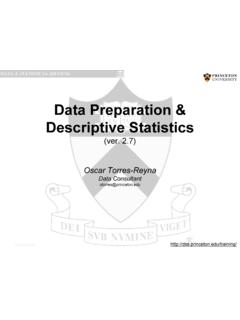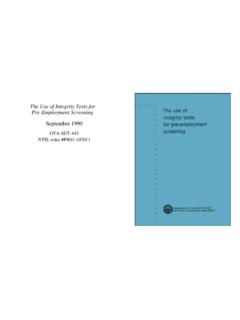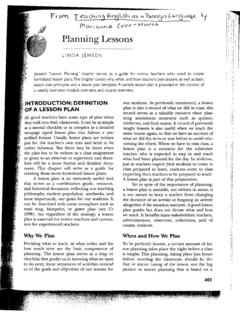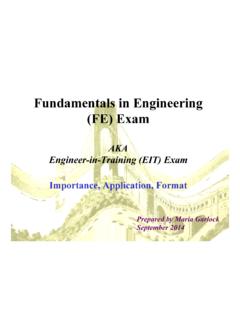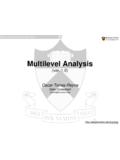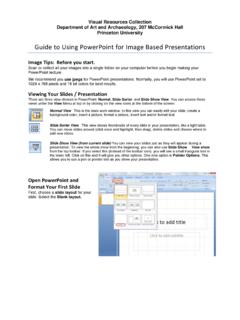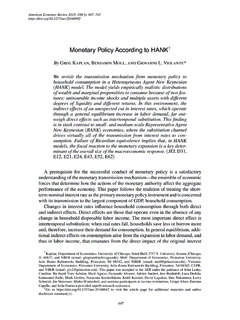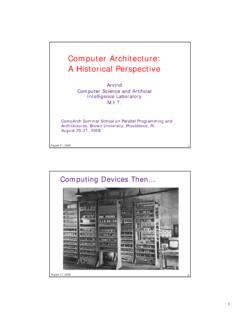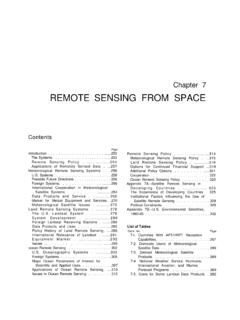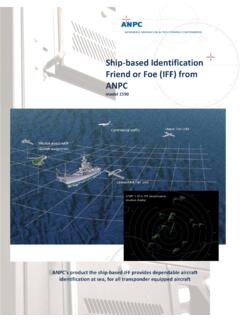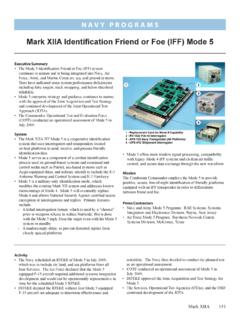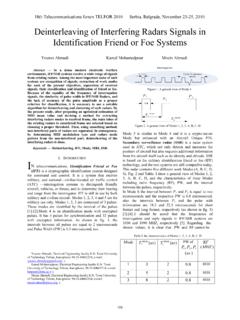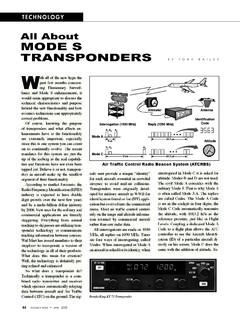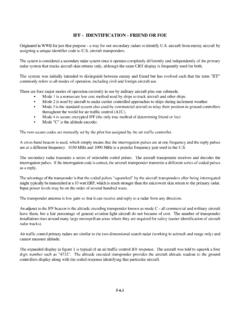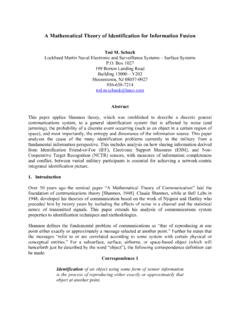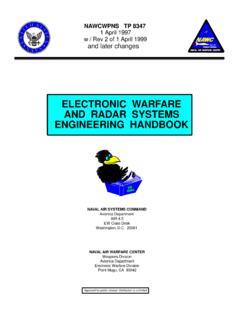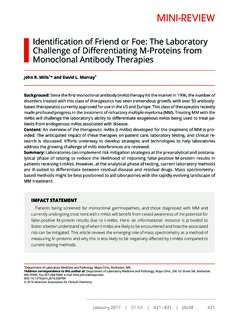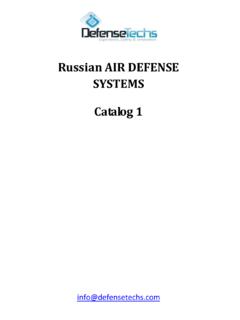Transcription of Avoiding Fratricide of Air and Sea Targets As
1 AvoidingFratricide ofAir andSea Targets4As described in the previous chapter, reducing fratriciderequires more than improving identification . This chap-ter discusses ways to improve both tactical knowledgeand identification to avoid air Fratricide . There areseveral technical approaches to better identification ; each ofthese is described briefly below with a discussion of itsadvantages and disadvantages. The chapter ends with a discus-sion of the interaction of military identification systems withcivilian air traffic control and a brief discussion of avoidingfratricide of MANAGEMENT Battle management includes collecting information aboutwhere combat resources are needed, setting priorities, andallocating resources to needs. The tactical knowledge or situational awareness provided by battle management is sointegral a part of air combat that its importance to avoidingfratricide is easily overlooked, Yet the foremost antifratricidemeasure is properly coordinating friendly efforts that improve coordination also improve combateffectiveness and that typically is their primary justification but these same efforts can help reduce Fratricide .
2 The Navy andthe Air Force discovered during joint operations in the PersianGulf War that air tasking orders (ATOs) were difficult totransmit between the Services strike planners. Air Force andNavy radios were not always compatible and the ATOs were sovoluminous that transmission was time ,consuming. These andother uncovered communication problems are now beingcorrected. The resulting improvement in attack efficiency willbe obvious, but better communication and coordination alsowill make Fratricide less likely.~- -- ------ ..- .. ~II1--14950 I Who Goes There: Friend or Foe?At the tactical level, long-range surveillancecan sometimes track an enemy airplane from themoment of takeoff. If a fighter can be seen takingoff from an enemy airfield, few would argue withthe assumption that it is an enemy airplane. Thiscapability is partially in hand today with theAWACS. The limitations of the system are rangeand, more importantly, tracking.
3 Once the enemyairplane gets close to a friendly airplane the radarmay no longer see them as separate Targets or theradar may loose track of the airplane when it fliesbehind mountains. Then, when a distinct radarecho is again detected, the tracking radar cannottell whether the aircraft came from an can hand down information, butgreater benefits accrue with a two-way communi-cation between some central coordinating pointand forward shooters equipped with IFF capabili-ties. For example, to avoid Fratricide , surface-to-air missiles are specifically allocated defensiveareas in which friendly aircraft are not to fly. Testsare currently underway to evaluate the feasibilityof transmitting target identification down toindividual missile batteries so that missiles andfighters can operate in the same area. But much ofthe information handed down from the centercould come from analysis of data collected by theindividual missile batteries in the ultimate goal for any identification andcommand system would be an array of individualshooters equipped with point-to-point identifica-tion of friend and foe (IFF) capabilities, collectinginformation and sharing it through some networkso identifications are based on a compositepicture built up from all available the possible exception of the missile-fightercoordination, none of the communications im-provements currently proposed or underdevelop-ment are being justified solely-or even pri-marily as antifratricide measures, but their con-tribution to Avoiding Fratricide could be substan-tial.
4 If allies can tap into the information-sharingnetwork, they can still get the benefit of IFFinformation without acquiring the IFFC hapter 3 discussed how cooperative systemsreally only identified friends; noncooperativetechniques are able to identify foes as identification of aircraft variesfrom the very simple-visual recognition todetection, analysis, and classification based onextremely subtle differences among target end of the Cold War will change theequations governing noncooperative IFF. In thosefuture Third World conflicts in which the UnitedStates has overwhelming air superiority, positiveidentification of enemies-and hence noncooper-ative IFF--will be important. After all, anyunidentified aircraft picked at random is likely tobe friendly under those conditions, so failure torespond to an IFF query will probably not bejustification to fire. At the same time, the techni-cal challenge now will be in many ways muchgreater than during the clearer confrontationbetween NATO and the Warsaw Pact forces,since both Western and Soviet equipment are nowwidely proliferated.
5 Therefore, allies and enemiesmight very well be using the same equipment, asthey indeed did during the Persian Gulf War. TheServices agree that no single measurement will beadequate to identify enemies, rather that a com-posite picture formed from many sources ofinformation will be needed to be definitive. Someare discussed Radio-Emission InterceptPerhaps the simplest noncooperative tech-nique short of visual identification -is passiveinterception of radio and radar radio and radar system transmits at charac-teristic frequencies,with characteristic signalmodulation, and-at least for radars--character-istic pulse shapes and repetition rates. Someaircraft will transmit radio-frequency energy rou-tinely, while others will at least occasionallytransmit. It is also theoretically possible to induceenemy aircraft to transmit signals, perhaps by ..Chapter 4 Avoiding Fratricide of Air and Sea Targets 51sending false communications requiring answersor by appearing to threaten the aircraft in a waythat forces the enemy pilot to turn on defensiveradars or otherwise communicate with his com-mand and control RadarCareful analysis of radar returns reveals muchmore about a target than just its bearing and after the development of radar, operatorsnoticed that the propellers of aircraft modulate thefrequency of the radar return in a characteristicway.
6 The modern equivalent is called jet enginemodulation (JEM). The air intakes of jet enginesreflect radar signals very efficiently. Some of theradar waves entering the inlets are reflected off ofthe rapidly rotating compressor or fan blades. Themotion of the blades causes a slight Doppler shiftin the frequency of the reflected waves. Thesesubtle frequency shifts are readily detectable bysophisticated radars and are, moreover, character-istic of particular jet principal limitation of identification by jetengine modulation is clear: the technique identi-fies engines, not aircraft. There are a limitednumber of military jet engines available world-wide and very different airplanes can be poweredby the same type of engine, At the same time,individual aircraft in a particular fleet might havedifferent engines. For example, some F-16shave been fitted with the General Electric F-1 10engine while others have been fitted with modi-fied Pratt and Whitney F-100 engine originallyused in the engine modulation should at the very leastdistinguish fighter aircraft from transport aircraft,These two types of aircraft use very differenttypes of engines: fighter engines typically havelow bypass ratio engines and therefore havesmall, high-speed fans, while transports have highbypass ratio engines with much larger, slowerfans.
7 This method will not, however, necessarilydistinguish military from civilian transports, Forexample, the commercial Boeing 757 and themilitary McDonnell Douglas C-17 both use thePratt and Whitney F-1 17 turbofan addition, the technique is highly dependenton a proper geometry between the radar and thetarget. This dependence can restrict the tech-nique s application in a dynamic air detailed information about the airplanestructure itself will be available from high-resolution radars (HRR) under or radar waves are just a form of electro-magnetic radiation, like light, and travel at thesame speed. Light travels about 300 meters in amicrosecond. A typical radar sends out pulses, orbursts of radio waves, that are on the order of amicrosecond in duration. This means that theradar pulses are many meters long. Resolvingfeatures much smaller than the radar pulse lengthis difficult; thus conventional radars are good atdetecting objects but not much use for providingdetails of objects as small as airplanes.
8 Targetsappear just as blobs on the radar screen. If,however, a radar had a very compact pulse,perhaps the individual reflective surfaces of anaircraft could be resolved, which would allowidentification. Such HRRs are currently in re-search and development. See figure challenges facing high-resolution radardevelopment are substantial. First, of course, isdesigning and building a radar that can emitpulses with duration of only several nanoseconds(billionths of a second). Proponents of high-resolution radar are confident that the technologyis available or can be developed. In addition,however, are the operational challenges. Forexample, each target will have a different echopattern depending on the perspective of theviewing radar. Side views will look nothing likehead-on views and data catalogs must be devel-oped of all potentially hostile aircraft seen fromall possible Mark Larnbert, cd.
9 , Jane s All the WorZd s Aircraft (CoulsdoU UK: Jane s Information Group, 1990), p. 748. The civilian designationfor the engine is PW2040.. - -- - - - - - .- ..52 I Who Goes There: Friend or Foe?IFigure 4-l High Resolution RadarIdentification with High-Resolution RadarA->Transmitted radar pulse<Reflected radar pulsenALTransmitted radar pulze<Reflected radar pulse\FoeFriend~~Reflected pulse\m IDENTIFICATIONI/-=/Catalog of radar signaturesOffice of Technology Assessment, , different aircraft can look similarthinner profile and is therefore more difficult tofrom particular directions. For example, from adetect. From certain attitudes, if the range is nottrade journal review of the Soviet Su-27 fighter:known, the forward portion of the Su-27 also From a head-on or trailing position, the Su-27resembles that of the USAF/General Dynamicsresembles the Navy/Grumman F-14, but has aF-16 because of its prominent bubble canopy and.
10 Chapter 4 Avoiding Fratricide of Air and Sea Targets F-18 from the Australian Air Force fliesbelow a similar-looking Su-27 from the former SovietUnion. Superficial resemblances of weapons can makequick identification difficult and forward aerodynamic strakes, which blend intothe wing leading edges. 2 The algorithms used to discriminate amongaircraft will not look at every detail but willextract and concentrate on certain defining char-acteristics. If an enemy knew which characteris-tics were used for discrimination, then it could tryto suppress or alter them. Thus, the algorithmswill need to be strictly secret and cannot be sharedwith all allies.~ Surface-to-Air Missiles andNoncooperative IFFD ifficulties of working out aircraft identifica-tion has forced surface-to-air missiles (SAMs)and air interceptors into different zones of respon-sibility. Typically, SAMs defend strips of air-space from which all friendly aircraft are ex-cluded; thus, anything entering the zone could beconsidered hostile and attacked.
